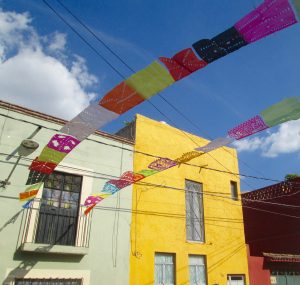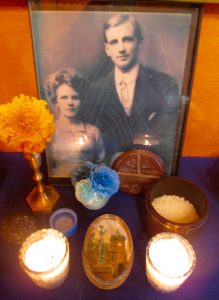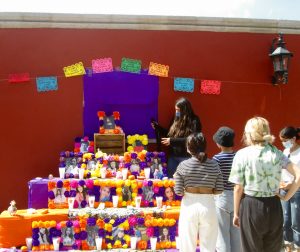When the wind blows through the corridor that is the street where I live, I can now hear from my third-floor apartment window a rustling sound, like the rustle of leaves in a thick stand of bamboo. But it’s not bamboo. It’s several strands of string on which my Mexican neighbors have hung, just this week — high above the cobblestone street, from one side of the street to the other — dozens of colorful paper flags.
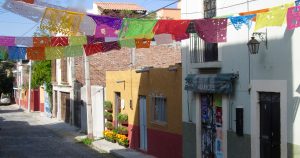
These flags, as I call them, fluttering in the wind, are more than festive and decorative, I learned. Their real name is papel picado (“perforated paper,” or “pecked paper”), a Mexican folk art dating from the Aztecs, that is filled with meaning. In essence, these tissue paper banners with perforated designs symbolize the fragility of life.
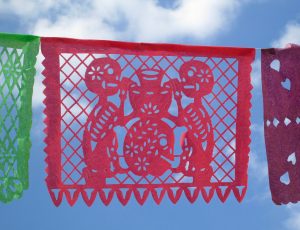
Although they’re a fairly common sight throughout the year here in San Miguel de Allende, these colorful papeles picados flying above the streets are particularly prevalent at this time, when Mexico celebrates Día de Muertos, Day of the Dead. And they are even more particularly prevalent this year.
I once read that this time of year – end of October into early November – is when the membrane between this world and the next is most porous. This is why people all over the world have always felt the need in this season to acknowledge the spooky. But leave it to the Mexicans to turn this occasion into a celebration.
This year, due to the coronavirus pandemic, there’ll be no grand events or people-packed costumed parades as in past years’ celebrations. (If you’re in town, be sure to visit www.quepasasanmiguel.org for a complete list of what is going on here.) But there will be altars (ofrendas) on display. These altars are the centerpieces of Day of the Dead, erected to honor those who have passed on and to invite their spirits back for a visit. And, of course, there’ll be the countless papeles picados fluttering in the wind overhead.
As in years past, I made a small altar this year to my Scottish paternal grandparents, John and Jessie Black (pictured below). Jessie died before I got to know her, but John died on Halloween Day, 1954, when I was nine. His mother, Helen Reid David Black (b. May 3, 1862, in Kirriemuir, Scotland; d. 1885 (?) in Natal, South Africa), is the heroine of my novel Jamie’s Muse. I was determined that she would not be forgotten.
On a walk in nearby Zeferino park yesterday I came across this altar being erected by a group of young women to the memory of Mexican women victims of femicide this year. As you can see below, papeles picados are sometimes incorporated into the ofrendas. Items placed on the altar are meant to signify the four elements – fire, water, earth, and air. Papeles picados represent air:
As for the origins of this folk art, I learned that the Aztec people first chiseled spirit figures into mulberry or fig tree bark to make a rough paper called amatl. Today, artisans lay up to fifty layers of tissue paper and punch intricate designs into them using fierritos, a type of chisel.
With so much up in the air these days — especially the outcome of the upcoming fractious U.S. presidential election, as well as the duration of the crippling coronavirus pandemic – when our collective nerves feel chafed raw, I find it strangely uplifting to stop, look up, and admire these Mexican papeles picados. They’re not white flags of surrender. Rather, they’re colorful flags of defiance.
Mexico is an old, wise country; and, as I’ve observed in the five years I’ve been fortunate enough to live here, its people tend to take the long view. I’m still learning from them.

